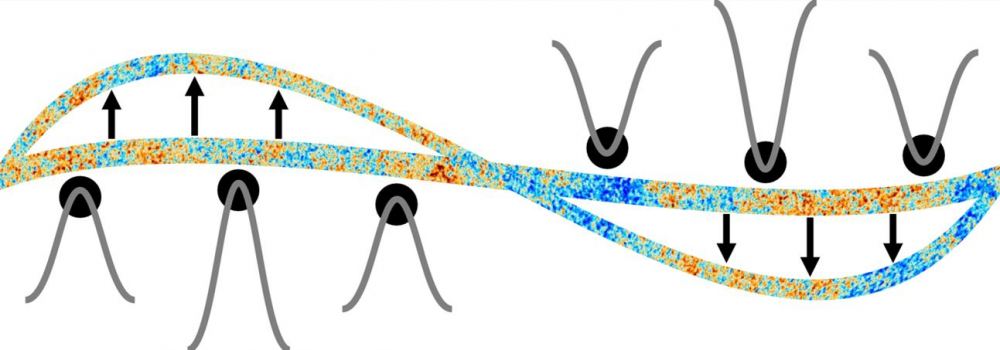

This graphic shows how large-amplitude fluctions on small scales in the cosmic background background could result in primordial black holes. Courtesy: ESA/Planck Collaboration/Jason Kristiano.
The earliest black holes in the Universe called primordial black holes (PBHs), are strong contenders to help explain why the Universe is heavier than it looks. There’s only one problem: these miniature monsters haven’t exactly been observed—yet. But, when astronomers do find them, they might turn out to be part of the Universe’s dark matter component.
Primordial black holes are one of several types of highly massive objects thought to exist in the Universe. We already know about stellar-mass black holes. They form during the deaths of hugely massive stars and generally end up containing up to dozens of solar masses. Then there are the supermassive black holes, embedded in the hearts of most galaxies. They sequester up to millions of solar masses.
The intermediate-mass black holes occupy the middle of the “black hole” spectrum. They’re another hot topic in black hole research circles. Appropriately enough, the masses of these black holes are between their stellar and supermassive counterparts. All these types of massive objects can collide with each other to grow bigger black holes. That generates gravitational waves that can be detected. The “ping” of each gravitational wave tells scientists a great deal about the objects colliding, including their masses.


While astronomers search for PHBs, others are looking to explain why they might be part of the dark matter component of the Universe. In addition, they could explain the origin of binary black holes detected in gravitational wave observations.
A team of researchers at the University of Tokyo examined the “problem” of PBHs. Their work suggests that there should be far fewer of these objects than current models show. But, nobody knows how many existed back then. So, astronomers search them out using gravitational wave observatories. Their discovery should open a window on conditions in the early Universe when PBH formed.
These miniature ones are fascinating to think about. “Many researchers feel they are a strong candidate for dark matter, but there would need to be plenty of them to satisfy that theory,” said graduate student and team member Jason Kristiano. “They are interesting for other reasons too, as since the recent innovation of gravitational wave astronomy, there have been discoveries of binary black hole mergers, which can be explained if PBHs exist in large numbers. But despite these strong reasons for their expected abundance, we have not seen any directly, and now we have a model which should explain why this is the case.”
The big question about PHBs: do (or did) they exist? And, can they be part of the dark matter component of the Universe? To answer that, Kristiano and his advisor Jun’ichi Yokoyama, searched through models of PBH formation. The best ones do not agree with the observed conditions of the leftover light fingerprint of the Big Bang. That’s called the cosmic microwave background (CMB). This is important, since PBHs formed in very early epochs of cosmic history, soon after the Big Bang. So, the team used the best model of PBH formation and applied quantum field theory to bring the model into alignment with reality.
Yokoyama explained the background behind their work. “At the beginning, the universe was incredibly small, much smaller than the size of a single atom. Cosmic inflation rapidly expanded that by 25 orders of magnitude. At that time, waves traveling through this tiny space could have had relatively large amplitudes but very short wavelengths. What we have found is that these tiny but strong waves can translate to otherwise inexplicable amplification of much longer waves we see in the present CMB,” said Yokoyama.
“We believe this is due to occasional instances of coherence between these early short waves, which can be explained using quantum field theory, the most robust theory we have to describe everyday phenomena such as photons or electrons. While individual short waves would be relatively powerless, coherent groups would have the power to reshape waves much larger than themselves. This is a rare instance of where a theory of something at one extreme scale seems to explain something at the opposite end of the scale.”
Those early small-scale fluctuations Yokohama describes affect some of the larger-scale fluctuations in the cosmic microwave background. Researchers can use measurements of wavelengths in the CMB to constrain the extent of corresponding wavelengths in the early Universe. That also puts some limits on any other phenomena that rely on the shorter, stronger wavelengths. And this is where the PBHs come back in.
“It is widely believed that the collapse of short but strong wavelengths in the early universe is what creates primordial black holes,” said Kristiano. “Our study suggests there should be far fewer PBHs than would be needed if they are indeed a strong candidate for dark matter or gravitational wave events.”
The next step relies on gravitational wave observatories and other types of observations. LIGO in the U.S., Virgo in Italy and KAGRA in Japan, are cooperating in observations aimed at finding the first PHBs. The results should help refine the ideas from Yokoyama’s team about PHBs and dark matter.
The Case of the Missing Black Holes
Constraining Primordial Black Hole Formation from Single-Field Inflation
Note on the Bispectrum and One-loop corrections in Single-field Inflation with Primordial Black Hole Formation
Computers are an integral part of space exploration, keeping them functioning when away from Earth.…
By the end of this decade, NASA, the Chinese National Space Agency (CNSA), Roscosmos, and…
Could a new, fifth force of nature provide some answers to our biggest questions about…
In 2015, the United Nations adopted the 2030 Agenda for Sustainable Development—the Sustainable Development Goals…
Astronomers have been battling threats to their clear skies on all fronts lately. One of…
If you were Captain of the first USS Enterprise, where would you go!? Humanity is…